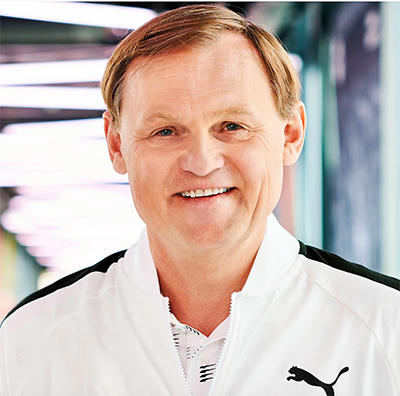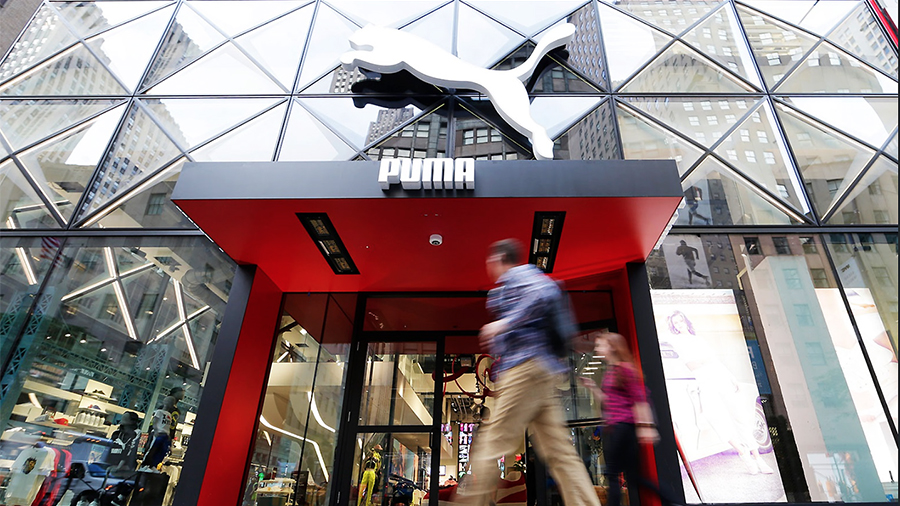Puma delivered 44 percent currency-neutral growth in the Americas region in the first quarter, boosted by the energy around Lamelo Ball’s basketball shoe, the brand’s return to performance running and golf’s recovery.
“I’m very, very proud of the North American numbers,” said Bjørn Gulden, Puma’s CEO, on a media call. “We have had a breakthrough in that market, especially due to the investment that we’ve made in basketball.”
 Companywide, Gulden said the first quarter marked a record for revenues in a quarter for the company and was the best first quarter for EBIT (earnings before interest and taxes). The performance builds on a record year in 2021 with growth of 31.7 percent in 2021 and the return to healthy growth in recent years.
Companywide, Gulden said the first quarter marked a record for revenues in a quarter for the company and was the best first quarter for EBIT (earnings before interest and taxes). The performance builds on a record year in 2021 with growth of 31.7 percent in 2021 and the return to healthy growth in recent years.
Puma achieved a CAGR (compound annual growth rate) of 12.3 percent from fiscal 2015 to fiscal 2021. Gulden said, “I’m happy to report that this momentum continues.”
Overall, sales in the first quarter ended March 31 increased 19.7 percent on a currency-neutral basis to €1.91 billion (+23.5 percent reported).
In the Americas, the 44.1 percent gain reflected continued high demand for the Puma brand, with currency-neutral gains of 38.6 in North America and 64.5 percent in Latin America. In euro terms, sales in the Americas grew 51.8 percent to €815.9 million.
Sales in the EMEA were up 25.5 percent on a currency-neutral basis, reflecting strong growth across all key markets in Europe. In euro terms, sales gained 23.8 percent to €708.8 million.
Sales in Asia/Pacific (APAC) declined 17.0 percent on a currency-neutral basis due to the current market environment in Greater China resulting from COVID-19-related restrictions and geopolitical tensions.
Greater China sales were down 37 percent. Gulden attributed the weakness largely to the move by the Better Cotton Initiative (BCI) early last year to suspend business in the Xinjiang province on concerns of labor abuses in the region that has led to a backlash against Western brands, which began in the latter part of the 2021 first quarter. In euro terms, APAC sales were down 12.4 percent to €387.4 million.
All product divisions grew double-digit. On a currency-neutral basis, footwear grew 18.2 percent to €941.3 million, apparel advanced 16.0 percent to €638.7 million and accessories jumped 32.2 percent to €332.2 million. The growth was driven by demand for its Performance categories—running, training, teamsports, golf, and basketball, as well as the sportstyle category. Accessories were boosted by the golf category, which includes the Cobra brand.
By channel, Puma’s wholesale business increased 23.3 percent on a currency-neutral basis to €1.53 billion, and direct-to-consumer (DTC) was up by 7.1 percent on a currency-neutral basis to €384.0 million.
Gulden said the smaller DTC gains reflected its “wholesale first” strategy that prioritizes inventory to support its wholesale partners to focus on adding shelf space.
Sales in owned and operated retail stores increased 21.3 percent on a currency-neutral basis, although that largely reflects easy comparisons when stores were closed due to the pandemic in the year-ago period. E-commerce dropped 13.2 percent on a currency-neutral basis. Excluding China, e-commerce sales were essentially flat. The decline also reflected tough comparisons against a 75 percent e-commerce gain in the 2021 first quarter.
Gross margins in the quarter eroded 130 basis points to 47.2 percent, mainly caused by an unfavorable geographical and channel mix and higher freight rates, while currencies had a slightly positive effect.
Operating expenses (OPEX) increased 18.6 percent to €712.8 million as a result of higher marketing expenses, more retail stores operating and higher sales-related distribution and warehousing costs. As a percent of sales, OPEX was reduced to 37.3 percent from 38.8 percent a year ago, with the improvement coming despite ongoing operating inefficiencies due to COVID-19, especially in the supply chain.
EBIT (earnings before interest and taxes) increased 27.0 percent to €196.0 million, with the EBIT margin improving 30 basis points. Net earnings increased 11.1 percent to €109.2 million, or €0.81 a share.
On the call, Gulden said Puma has benefited from favorable industry trends, including growth in sports participation boosted by the pandemic. The continuation of the global sneak trend and casualization also supported the brand’s growth.
Internally, Puma is seeing “very positive feedback from retailers” for its product range and continues to have a “very, very strong order book.”
Providing an update on progress across key category platforms, Gulden said Puma had experienced a “comeback in football,” or American football, with the signing of star players including Neymar, Kingsley Coman and Christian Pulisic, the brand’s investment in teams and successful products launches. Gulden said, “In many markets, we are now approaching 20 percent market share, and we think that Puma is very, very strongly positioned for the future in this major sport.”
In running, Puma has been known for its track & field spikes but has recently come back into the broader performance running category with the success of its Nitro range. Puma has received strong reviews for its running shoes, and its run athletes are finding success in marathons and other races. Said Gulden, “We are back again to being a performance running brand after many years not taking part in this business. And I can tell you there’s excitement internally and externally in this sector, which is having a boom.”
Training is also a growing category for Puma, helped by the global popularity of yoga and Pilates.
Puma re-entered the basketball category three-and-a-half years ago and has seen benefits when it signed LaMelo Ball, the NBA’s Rookie of the Year, in the 2020/21 season and who played his first All-Star game this year. Said Gulden, “He’s been extremely successful with us, and his signature shoes have sold out every time we launch a new version.”
Gulden also said the return to basketball supports its classics business with shoes returning from the 70s, 80s and 90s. This September, Puma will release a signature shoe for Breanna Stewart, the first female basketball player to release a signature shoe in twelve years.
On the lifestyle side, Puma’s Select range continues to see benefits from collaborations with fashion labels Butter, Liberty of London, Maison Kitsuné, and Rhuigi. The company is also increasing its investments in classics such as the Slipstream, Mayze, CA Pro, T7, and Suede. Gulden believes that only Adidas comes close to Puma’s archive offerings. Men’s sportstyle will look to build on its recent success with the RS series.
Puma’s Motorsport Formula One category is “booming” and sees benefits from next week’s inaugural Miami Grand Prix. Finally, kids has received more attention of late and golf has seen a strong turnaround throughout the pandemic, both with Puma’s footwear and apparel ranges and Cobra clubs.
“Golf was a category that people almost thought was dead, but it’s come back during COVID,” said Gulden. He said the growth came despite the category being impacted by COVID-related factory shutdowns last year in Vietnam.
Looking ahead, the company maintained its guidance for 2022. Currency-adjusted sales growth is projected to be at least ten percent, with upside financial potential in 2022. Operating result (EBIT) is expected to be in the range of €600 million and €700 million, up from €557 million) and net earnings are projected to improve correspondingly.
Gulden said, “While we will stay focused on our growth momentum by servicing our retail partners and consumers in the best possible way, we expect inflationary pressures from higher freight rates and raw material prices, as well as operational inefficiencies due to COVID-19 and the Ukraine crisis to dilute our profitability in 2022.”
Photos courtesy Puma
















